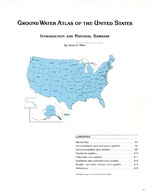Ground Water Atlas of the United States: Introduction and national summary
Links
- More information: USGS Index Page (html)
- Document: Report (37.21 MB pdf)
- Larger Work: This publication is Chapter A of Ground Water Atlas of the United States
- Download citation as: RIS | Dublin Core
Abstract
The Ground Water Atlas of the United States provides a summary of the most important information available for each principal aquifer, or rock unit that will yield usable quantities of water to wells, throughout the 50 States, Puerto Rico, and the U.S. Virgin Islands. The Atlas is an outgrowth of the Regional Aquifer-System Analysis (RASA) program of the U.S. Geological Survey (USGS), a program that investigated 24 of the most important aquifers and aquifer systems of the Nation and one in the Caribbean Islands (fig. 1). The objectives of the RASA program were to define the geologic and hydrologic frameworks of each aquifer system, to assess the geochemistry of the water in the system, to characterize the ground-water flow system, and to describe the effects of development on the flow system. Although the RASA studies did not cover the entire Nation, they compiled much of the data needed to make the National assessments of ground-water resources presented in the Ground Water Atlas of the United States. The Atlas, however, describes the location, extent, and geologic and hydrologic characteristics of all the important aquifers in the United States, including those not studied by the RASA program.
The Atlas is written so that it can be understood by readers who are not hydrologists. Simple language is used to explain technical terms. The principles that control the presence, movement, and chemical quality of ground water in different climatic, topographic, and geologic settings are clearly illustrated. The Atlas is, therefore, useful as a teaching tool for introductory courses in hydrology or hydrogeology at the college level and as an overview of ground-water conditions for consultants who need information about an individual aquifer. It also serves as an introduction to regional and National ground-water resources for lawmakers, personnel of local, State, or Federal agencies, or anyone who needs to understand ground-water occurrence, movement, and quality.
The purpose of the Ground Water Atlas of the United States is to summarize, in one publication with a common format, the most important ground-water information that has been collected over many years by the USGS, other Federal agencies, and State and local water management agencies. The purpose of this introductory chapter is to describe the content of the Atlas; to discuss the characteristics, use, and limitations of the maps and other types of illustrations used in the different chapters of the book; to summarize the locations of the principal aquifers on a Nationwide map; and to give an example of an aquifer in each principal hydrogeologic setting.
Study Area
| Publication type | Report |
|---|---|
| Publication Subtype | USGS Numbered Series |
| Title | Ground Water Atlas of the United States: Introduction and national summary |
| Series title | Hydrologic Atlas |
| Series number | 730 |
| Chapter | A |
| DOI | 10.3133/ha730A |
| Year Published | 1999 |
| Language | English |
| Publisher | U.S. Geological Survey |
| Contributing office(s) | U.S. Geological Survey |
| Description | 15 p. |
| Larger Work Title | Ground Water Atlas of the United States |
| First page | A1 |
| Last page | A15 |
| Country | United States |


